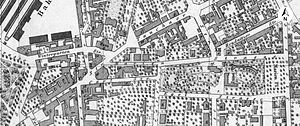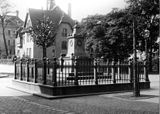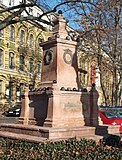Milk Island
The Milchinsel was a garden in the Marienvorstadt district of Leipzig , which was considered one of the most popular places to visit because of its dairy farming.
history
The land on the Milchinsel was owned by the entrepreneur and patron Carl Lampe (1804–1889). In 1807, Lampe's father, Johann Caspar Lampe, bought a plot of land in Marienvorstadt. The "Egelspfuhl" called Erblehngut had its name from a puddle , about between today's Marienplatz and the road to the milk island where since the 16th century commercially Medical leeches were obtained. Today the name of Egelstraße, which was built in 1845, still reminds of it.
The inheritance stretched from Hintergasse (today Schützenstrasse) to today's Marienplatz; In 1807 it was sold to the general tax inspector Ernst Conrad Dähne through a foreclosure auction for 14,000 Reichstaler . Since, according to the Saxon state constitution at that time, those belonging to the “ reformed religion ” were not allowed to own property of their own, Lampe paid the full purchase price to Dähne, who thus acquired the property for Lampe. After the ban was lifted, the Dähne estate was given to him on September 20, 1815 as his property. The property - the "Egelspfuhlgarten" or the so-called "milk island" - was the family seat of the Lampes. There was a farm building and a two-story residential building with an attic and hipped roof behind it .
The “Zur Milchinsel” garden restaurant opened here was one of the most popular excursion restaurants during the Biedermeier period because of its dairy industry. Today the names of the "Inselstraße", named in 1839, and the street "An der Milchinsel", named in 1884, still remind of this in Marienvorstadt. The Milchinsel was initially only inhabited by the Lampe family in summer. The Lampes spent the winter in their town house on Katharinenstrasse.
On October 19, 1813, the Milchinsel, located directly in front of the rear gate, was one of the scenes of the Battle of the Nations near Leipzig . The Milchinsel, which was stormed on October 19, 1813, was one of the first conquered areas of Leipzig. As a result, Russians and French were billeted on Milk Island.
From May to October 1, 1820, Prince Karl Philipp zu Schwarzenberg (1771-1820), the commander-in-chief of the allies in the Battle of Nations of 1813, lived in a garden house on Milk Island. He had come to Leipzig to have the consequences of his stroke in 1817 treated homeopathically by Samuel Hahnemann (1755–1843) . After a relapse on October 1, 1820, the Saxon king had him transferred to the royal house on the market, where he died on October 15.
From 1838 the construction of the new “ suburb in front of the back gate ” took place. Carl Lampe made parts of his property available for this purpose. In 1839, the intersection of Mittelstrasse (since 1947 Hans-Poeche-Strasse) and Reudnitzer Strasse was created in the area of Milk Island, in 1844 Marienstrasse (since 1949 Chopinstrasse) and part of Egelstrasse. The lamp villa was given the new address Marienstraße 16; it was now completely surrounded by houses and gardens that directly adjoined the suburbs of Schönefeld and Reudnitz .
The buildings have been rebuilt several times over the years. Around 1880 there were two houses in a large park. Carl Lampe lived in the larger house with his widowed daughter and her son. His eldest son's family also lived there. The families of two sons and a daughter Lampes lived in the smaller house. The larger house initially had a rectangular floor plan, later it was given two towers, which were flagged on certain occasions. In 1878 it was a representative two-storey building with multiple wings, located in a park-like garden with a fountain and small garden houses.
Spherical monument
Like the so-called Apelsteine , the spherical monument was also erected to commemorate the Battle of the Nations near Leipzig . In front of the back gate, one of the outer city gates of Leipzig , the Prussians fought the French in the morning hours of October 19, 1813. After the troops of III. The Prussian Corps had stormed Milk Island, they were then able to take the adjacent back gate and finally united with the troops of Marshal Blücher (1742-1819) in front of the Hallesches Tor . The area around the Milk Island is one of the parts of the Leipzig city area that the allies conquered first.
For this reason, Lampe had a monument erected on his private property directly in front of the residential building at Marienstraße 16 at his own expense, as city funds and public spaces were not available for it. The formerly private stand now forms the intersection of Hans-Poeche-, Reudnitzer, Chopin- and Inselstraße.
On July 5, 1845, the spherical monument made of 20 cannon balls and a large stone was inaugurated. The stone marked the grave of a fallen Prussian officer in the garden of Milchinsel; he had to be moved during the parcelling. The old monument, which was located in the same place as the present one, was surrounded by a wooden fence with 20 pillars, on each of which rested a sphere from places in which battles of the Battle of Nations had taken place and which were destroyed in the process.
Damage to the monument has occurred over the years. Therefore, Lampe wanted to renew the monument and organized a public collection, which, at around 1,000 thalers, only brought in a small part of the costs. The laying of the foundation stone of the new spherical monument based on a design by the director of the Berlin Building Academy August Hermann Spielberg (1827–1886) took place on August 5, 1863. The main cost of the memorial from Rochlitz porphyry wore lamp itself.
A thorough restoration of the monument took place from 1989 to 1992. The reconstruction of the monument remained incomplete, however, as the originally existing edging (lattice fence) made of cast iron (see Fig. New spherical monument around 1909) has not yet been restored. The motifs of the edging designed by senior building officer Friedrich August Stüler (1800–1865) from Berlin made reference to the victims and the devastation caused by the battle. The original edging was also a victim of theft and has not been found since then.
Inscriptions
North side:
"IN REMEMBRANCE / OF LEIPZIG'S EMERGENCY AND RESCUE / IN OCTOBER 1813 / THIS MONUMENT WAS FOUNDED BY C. LAMPE / ON JULY 5, 1845, THE ANNIVERSARY OF THE LAST / LIBERATION STRUGGLE OF PARIS, AND WITH HELP / PUBLIC EMPLOYEES 1863 FOR THE 50TH COMMEMORATION OF THE BATTLE OF THE Nations. "
South side:
"October 19th, 1813"
Individual evidence
- ↑ Gina Klank, Gernot Griebsch: Lexicon of Leipzig street names. Verlag im Wissenschaftszentrum Leipzig, Leipzig 1995, ISBN 3-930433-09-5 , p. 60
- ^ Werner Wendt: Contributions to the social history of Leipzig merchants in the 19th century using the example of Johann Marc Albert Dufour-Féronce (1798–1861), Gustav Harkort (1795–1865) and Carl Lampe (1804–1889). Frankfurt (Main), Univ., Diss., 2010, p. 169
- ^ Werner Wendt: Contributions to the social history of Leipzig merchants in the 19th century using the example of Johann Marc Albert Dufour-Féronce (1798–1861), Gustav Harkort (1795–1865) and Carl Lampe (1804–1889). Frankfurt (Main), Univ., Diss., 2010, p. 170
- ↑ Gina Klank, Gernot Griebsch: Lexicon of Leipzig street names. Verlag im Wissenschaftszentrum Leipzig, Leipzig 1995, ISBN 3-930433-09-5 , p. 109
- ↑ Gina Klank, Gernot Griebsch: Lexicon of Leipzig street names. Verlag im Wissenschaftszentrum Leipzig, Leipzig 1995, ISBN 3-930433-09-5 , p. 25
- ↑ a b c Sophia Victoria Elisabeth (Lilly) v. Carlowitz, b. Dufour-Feronce: History of the Milk Island. 12 typewritten sheets in the Leipzig City History Museum, Inv. A / 2256/2010
- ↑ A. Prokesch: Memories from the life of Field Marshal Prince Carl zu Schwarzenberg. Vienna 1861, p. 304 ( digitized )
- ^ Kathrin Schreiber: Samuel Hahnemann in Leipzig. The development of homeopathy between 1811 and 1821. Georg Thieme Verlag, 2002, p. 68 ff. ( Partially digitized )
- ↑ Gina Klank, Gernot Griebsch: Lexicon of Leipzig street names. Verlag im Wissenschaftszentrum Leipzig, Leipzig 1995, ISBN 3-930433-09-5 , p. 96
- ↑ Gina Klank, Gernot Griebsch: Lexicon of Leipzig street names. Verlag im Wissenschaftszentrum Leipzig, Leipzig 1995, ISBN 3-930433-09-5 , p. 177
- ↑ Gina Klank, Gernot Griebsch: Lexicon of Leipzig street names. Verlag im Wissenschaftszentrum Leipzig, Leipzig 1995, ISBN 3-930433-09-5 , p. 46
- ^ Werner Wendt: Contributions to the social history of Leipzig merchants in the 19th century using the example of Johann Marc Albert Dufour-Féronce (1798–1861), Gustav Harkort (1795–1865) and Carl Lampe (1804–1889). Frankfurt (Main), Univ., Diss., 2010, p. 169
- ^ Werner Wendt: Contributions to the social history of Leipzig merchants in the 19th century using the example of Johann Marc Albert Dufour-Féronce (1798–1861), Gustav Harkort (1795–1865) and Carl Lampe (1804–1889). Frankfurt (Main), Univ., Diss., 2010, p. 172
- ^ Werner Wendt: Contributions to the social history of Leipzig merchants in the 19th century using the example of Johann Marc Albert Dufour-Féronce (1798–1861), Gustav Harkort (1795–1865) and Carl Lampe (1804–1889). Frankfurt (Main), Univ., Diss., 2010, p. 173
- ↑ Markus Cottin et al .: Leipzig Monuments. Edited by the Leipziger Geschichtsverein e. V., Sax-Verlag, Beucha 1998, ISBN 3-930076-71-3 , 162
literature
- Illustrirte Zeitung No. 1048 of August 1, 1863, p. 88.
- Werner Wendt: Contributions to the social history of Leipzig merchants in the 19th century using the example of Johann Marc Albert Dufour-Féronce (1798–1861), Gustav Harkort (1795–1865) and Carl Lampe (1804–1889). Frankfurt (Main), Univ., Diss., 2010, urn : nbn: de: hebis: 30-88457 .
- Karsten Hommel: Carl lamp. A Leipzig educated citizen, entrepreneur, promoter of art and science between Romanticism and Empire. Sax-Verlag, Beucha 2000, ISBN 3-930076-95-0 .
- Horst Riedel: Stadtlexikon Leipzig from A to Z. Pro Leipzig, Leipzig 2005, ISBN 3-936508-03-8 , pp. 325, 403.
- Markus Cottin et al .: Leipzig monuments. Edited by the Leipziger Geschichtsverein e. V., Sax-Verlag, Beucha 1998, ISBN 3-930076-71-3 .
- Gina Klank, Gernot Griebsch: Lexicon of Leipzig street names. Verlag im Wissenschaftszentrum Leipzig, Leipzig 1995, ISBN 3-930433-09-5 .
Web links
Coordinates: 51 ° 20 ′ 34 ″ N , 12 ° 23 ′ 27 ″ E











